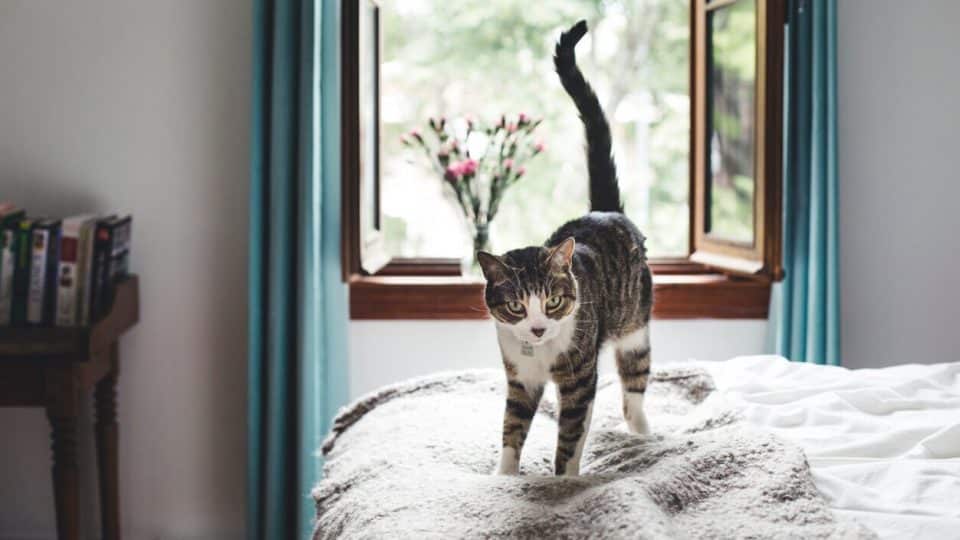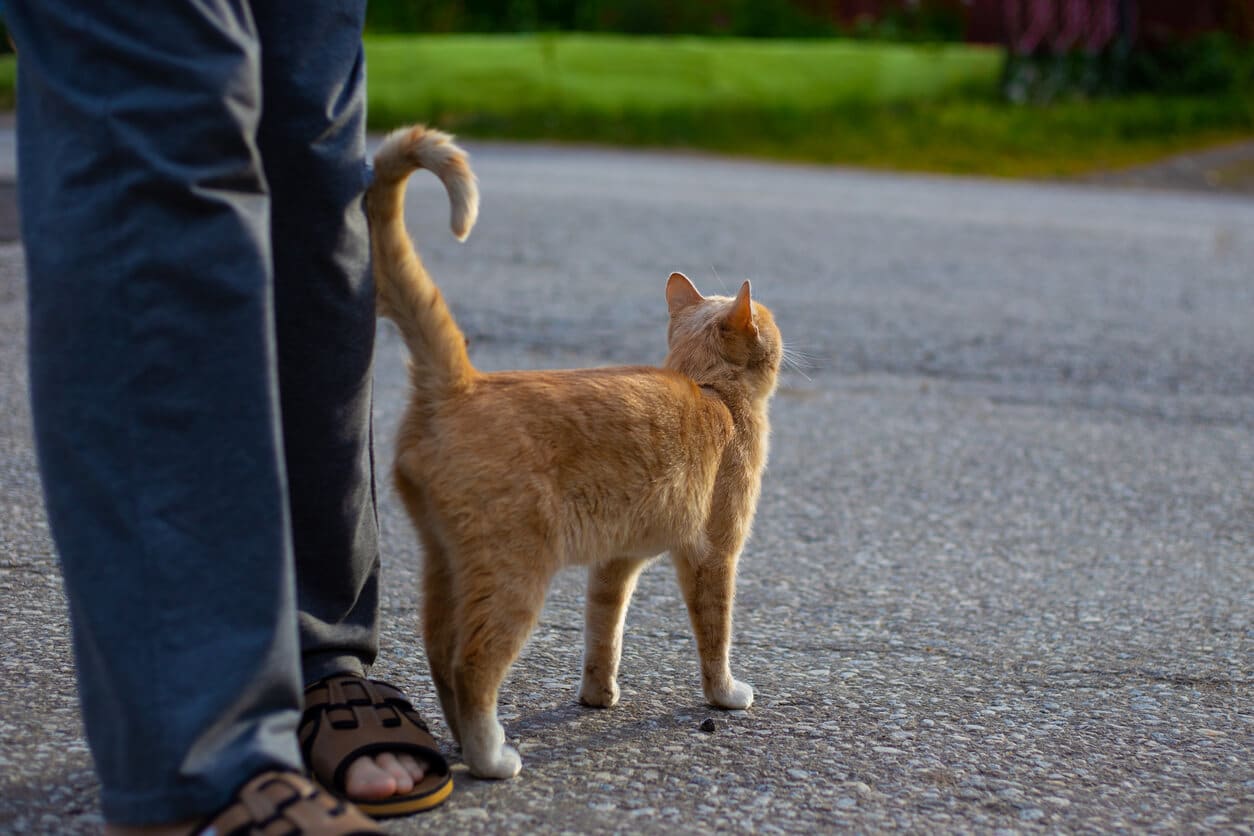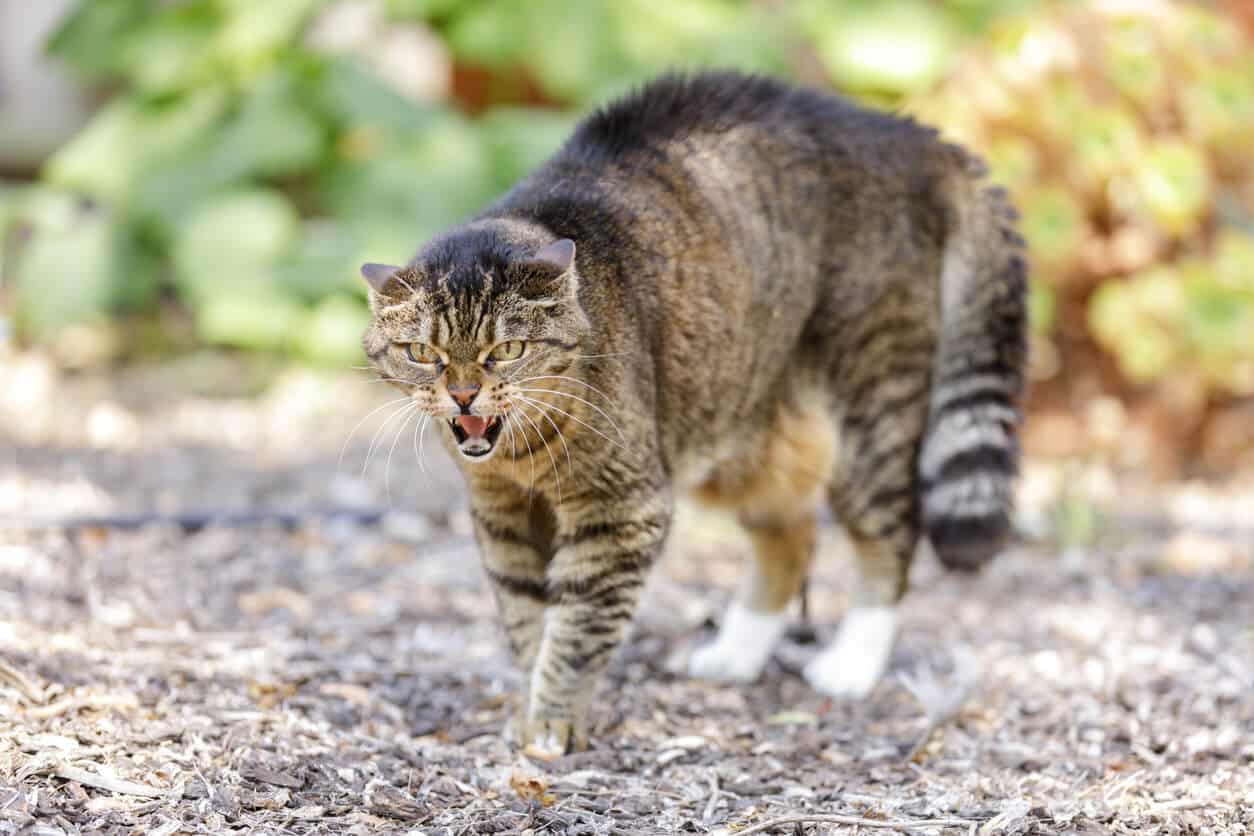While you might share your feelings through facial expressions like frowning and smiling, cats communicate their emotions via body language—including wagging their tails.
The position and movement of your cat’s tail can mean anything from affection and curiosity to uncertainty and aggression. So, context clues play a key role in deciphering cat tail language. Paying attention to your cat’s tail movements can give you a lot of information about their mood, which makes it easier to support their needs in every situation.
Learning to understand what your cat’s tail means can also improve your relationship with your pet. That’s why tail wagging is one important movement to note since it’s not usually a friendly greeting. Rather, your cat may wag their tail—or swish, flick, curl, and whip it—to show irritation, explains Stephen Quandt, a certified feline training and behaviour specialist (CFTBS).
With help from Quandt, we’ve compiled a list of 17 tail postures and their meanings, along with some context clues that might help guide your interpretation.
17 Cat Tail Positions, Explained
Cats don’t just use their tails for communication. They also rely on them for essential movement and balance.
A cat’s tail, which is part of the spinal column, contains six muscles that allow it to move up, down, and around. Most of these movements are subconscious, like the split-second reflex that prompts you to extend your arms when balancing.
When it comes to social signalling, experts don’t know for certain just how much tail movement is conscious. They do know that cats don’t wag their tails for the same reasons as dogs. Dogs will often wag their tails when they’re happy, for example.
Not sure about your cat’s mood? Watching for other body language clues can help you recognise a happy tail and one that wants some space. “The tail is only one body part that cats use to communicate non-verbally. They also use their eyes, whiskers, ears, and body position,” Quandt says.
1. Upright and straight = friendly
Your cat may position their tail straight and upright when you talk to them as a sign of happiness. “The higher the tail, the better they feel,” Quandt says. You might think of this position as a show of happiness or a friendly greeting. This tail can also mean your cat’s in the mood for some attention.
According to Quandt, cats don’t show off a happy tail just to be cute. They’re actually making the scent glands located around the anus and base of their tail available for sniffing.
2. Low tail flick = conflicted or agitated
This posture may mean your cat is conflicted, upset, or even getting ready to attack its prey (or toy mouse). Watch out for signs of agitation, including dilated pupils, pinned ears, and tense body posture. If you’re petting your cat and they give a low wag, they may want you to take a step back.
3. Held low and straight = poised for action
This means your cat is ready to pounce! A cat’s tail plays an important role in balancing, and a tail extended straight behind them can help them make rapid jumps and swift turns.
4. Pointing slightly down = cautious
A tail carried low can indicate that your cat feels concerned, cautious, or possibly aggressive.
Some cat breeds, including Persians, tend to carry their tails naturally low, so it may help to consider other context clues. If your cat isn’t happy, you might also notice their head slightly down and their chin tucked. They may be hesitant to approach or meow nervously.
5. Held low and curled at the top like a question mark = hesitant
A low tail that curls up may mean your cat is cautious or unsure about their surroundings. This could happen when they enter a new environment or meet someone for the first time.
They’ll quickly shift to a defensive or aggressive stance if they sense a threat.
6. Tucked between the legs = afraid
When your cat tucks their tail between their legs, they’re typically afraid of something in their environment, like another cat, a dog, or maybe even a loud vacuum cleaner. A tail tuck can also be a display of submission to someone more dominant.
In some cases, a tucked tail may mean your cat is in pain, so it may be worth looking for signs of injury, like a limp, abrasion, or swelling. If you have any doubts about your cat’s health, it’s always wise to call a vet.
7. Pointing up and gently undulating = curious
Notice your cat’s tail pointing up and gently bouncing? That’s usually a sign of curiosity. Your cat’s tail may give a gentle little wag when they explore new environments or investigate something interesting—like that package you just opened.
8. Pointing up and curled at the top like a question mark = playful
This tail position means your cat feels curious, inquisitive, or playful. They may be on high alert, ready to pounce or play at a moment’s notice. Your cat might also feel relaxed and happy when their tail looks like this, and you may notice this posture as they purr or rub against you.
9. Slow swish = curious or relaxed
A gently waving tail can mean your cat feels curious or playful.
Quandt says cats’ tail movement may be due to the sounds they hear, which trigger their inquisitive behaviour. If your cat’s tail slowly swishes when sleeping, it’s likely only partially asleep—as both predators and prey, cats remain in tune with their surroundings even while resting.
10. Flicking or swishing back and forth = afraid or playful
A cat’s tail typically swishes back and forth when they feel afraid. That said, this posture can also suggest a playful mood.
Paying attention to other cues can help you decipher how they’re feeling. For instance, a stiff body position and flattened ears may point to fear. If their ears and body remain upright, on the other hand, they may be ready for some playtime.
11. Quick thrashing = annoyed
A thrashing or swiftly wagging tail generally means annoyance or uncertainty. The intensity and force behind their tail movements can offer more clues to their emotional state, but it’s also important to consider your cat’s individual limits.
“Some cats will progress from a mild lashing directly to swatting without giving other warning signs, including a more severe thrashing of the tail,” Quandt says. “Other cats may thrash fairly hard and still not progress to swatting or other methods of defence.”
Generally speaking, if you notice dilated pupils, ears against the head, and hissing, it’s best to give your cat some space.
12. Upright and quivering = excited
Usually, this means your cat is really excited to see you, especially if they also purr, rub against you, or give you a head butt or two.
In some cases, a quivering tail could suggest anxiety or insecurity. Some male cats—especially unneutered cats—may also have this posture while urine marking.
13. Wrapped or hooked tail = affectionate
When a cat wraps their tail around you, it’s a sign of affection and companionship. Sometimes, you may even spot closely bonded cats with their tails entwined.
14. Wrapped around their own body = defensive or afraid
If your cat wraps their tail tightly around their body, they may feel defensive or fearful. This tail means they’re attempting to protect themselves from injury.
To help a fearful cat, you can offer a safe place of retreat, like another room, cubby, or perch.
15. Puffed up tail = frightened
Quandt advises that cats puff up their fur to appear larger and more dangerous when they get startled or spooked. This is called piloerection. Your cat may puff just its tail or its entire body, including its face. It might also arch its back, hiss, growl, and begin backing away with its eyes locked on the threat.
16. Waving while lying down = mildly annoyed or dreaming
This tail can mean your cat feels a little irritated with something, but their annoyance hasn’t reached a point where they feel motivated to stand up or move, according to Quandt.
For example, maybe you have to grab something and ever-so-slightly nudge them from their perfect napping spot on your lap.
Your cat’s tail may also twitch involuntarily during deep sleep.
17. Tail tip movements = content and relaxed
Sometimes you might notice the tip of your cat’s tail moving slowly. This typically means your cat feels content and relaxed.
Do Cats Wag Their Tails to Communicate with Each Other?
Cats may wag their tails when looking at each other if they’re communicating aggression. They may also raise their tail as a friendly greeting or curl it into a slight question mark if they feel unsure about the interaction.
Along with tails, cats also use their whiskers, ears, eyes, and body positioning to communicate with each other. According to Quandt, cats might adopt different postures and positions in response to the social exchange. Body language and verbal cues help other cats receive the intended message clearly.
But sometimes, cats may ignore or disrespect communication signals from other cats. If you notice signs of irritation or aggression in your cats, you can sometimes redirect their attention with a favourite treat or toy.
Not sure whether your cats are fighting or playing? They’re probably fighting if you notice:
- flattened ears
- puffed fur
- hissing, growling, or spitting
Can cats communicate without a tail?
Even if your cat doesn’t have a tail to wag, they can still rely on other non-verbal cues to communicate, including body positioning, eye contact, ear positioning, and pheromones.
Without a tail, their balance may be slightly off. Fortunately, cats have other mechanisms and skills for maintaining their balance, such as a highly developed inner ear, Quandt says.
Is It OK to Pet a Cat’s Tail?
It’s just fine to pet a cat’s tail—as long as they don’t mind, of course.
Keep in mind, though, that petting a cat from their back all the way to the tip of their tail can have varying effects. Most cats are highly sensitive around the base of their tail, which is why they yowl when it’s stepped on. This extreme sensitivity could also result in petting-induced aggression, Quandt says.
Some cats may tolerate this type of petting, and some may enjoy it. Others, however, may not like it at all. The reaction will depend on your cat’s preferences and petting tolerance.
As always, you can get more details about how your cat feels by considering all of their body language, not just their tail movements. If they rub against you or purr as you pet them, you’re probably just fine to continue. If they stop purring, swat or nip you, or tense up, try taking a break and give them some space—they’ll come back for more attention when they’re ready.






